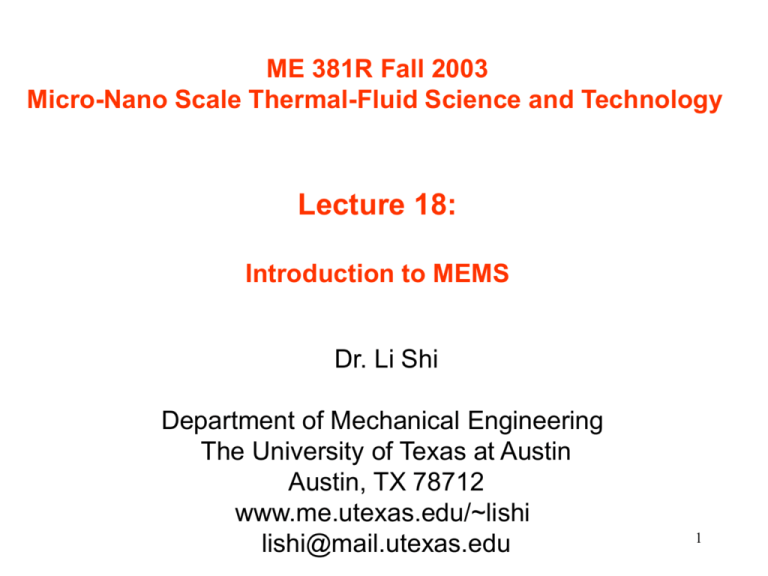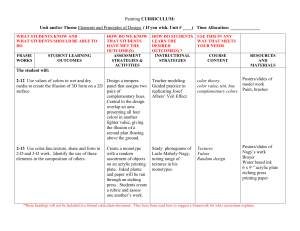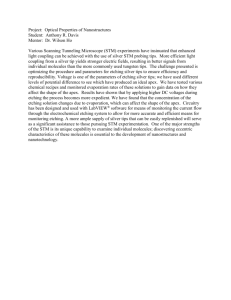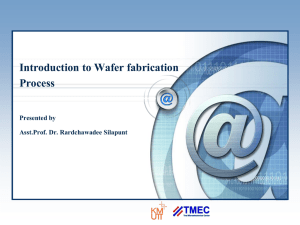Introduction to MEMS - Department of Mechanical Engineering
advertisement

ME 381R Fall 2003 Micro-Nano Scale Thermal-Fluid Science and Technology Lecture 18: Introduction to MEMS Dr. Li Shi Department of Mechanical Engineering The University of Texas at Austin Austin, TX 78712 www.me.utexas.edu/~lishi lishi@mail.utexas.edu 1 Outline • MEMS: Applications • Pattern transfer Method - Lithography • Subtractive Method - Wet and Dry Etching • Additive Method } Basic Fabrication Techniques - Thin Film Deposition • Example (Cantilever Beam) 2 MEMS Applications 3 http://mems.colorado.edu/c1.res.ppt/ppt/g.tutorial/ppt.htm MEMS Applications 4 http://mems.colorado.edu/c1.res.ppt/ppt/g.tutorial/ppt.htm MEMS Applications http://evlweb.eecs.uic.edu/scharver/asci/mems.html This image depicts a mirror system moved by a small rotating gear 5 MEMS Fabrication Techniques • Pattern Transfer Method : • Photo Lithography • E-beam Lithography • Nano-imprinting Lithography • Subtractive Method : • Wet Etching • Dry Etching • Additive Method : • Thin Film Deposition 6 Photolithography • Energy • • Mask • • Change cross linking of polymer chains of a photo-sensitive polymer called photoresist, and modify its dissociation rate in a developer similar to that for developing photos Absorber (Dark Area) & window (Open area) Resist • Transfer image from mask to wafer 7 Photolithography • Positive Photoresist - the polymer is weakened and more soluble in the developer • Negative Photoresist - the polymer is hardened and less soluble http://www.ece.gatech.edu/research/labs/vc/theory/photolith.html 8 Exposure Systems Photolithography Z 2bmin 3 g 2 2bmin 2 NA • Contact – not limited by diffraction • Proximity – 2 ~ 20 m gap, limited by diffraction • Projection – limited by diffraction 9 Electron Beam Lithography • • • • Minimum beam size (5nm) for optical & X-ray masks, and nano-devices Direct writing on resist-coated substrate No Mask 10 Energy Sources Sources Energy • Energy E h hc • Minimum Line Width R 1.22 f d 11 Comparison Comparison Advantage Optical Electron Beam Low ~High precision Fast exposure speed Relatively low cost No diffraction Easy to control Available for small features Light diffraction Alignment problem Disadvantage Debris between mask and wafer Needs vacuum High system cost Slow 12 Nano-imprinting Lithography: Fused Silica Template 1. Orient substrate and treated template Release Layer 2. Dispense drops of low viscosity UV curable low viscosity organosilicon monomer 3. Close gap and illuminate with UV (Room Temperature, Low Pressure) Planarization Layer Substrate Low Viscosity Monomer UV blanket expose HIGH resolution, LOW aspect-ratio relief 4. Separate the template from the substrate 5. Halogen break-thru etch followed by oxygen etch Residual Layer HIGH resolution, HIGH aspect-ratio feature Step and Flash Imprinting Lithography (S-FILTM) Courtesy: Profs. C. G. Willson & S.V. Sreenivasan, UT Austin 13 S-FIL Patterned Nanowires Sub-40 nm contacts 30 nm dense lines 20 nm isolated lines Courtesy: Profs. C. G. Willson and S.V. Sreenivasan 14 Subtractive Method Wet and Dry Etching • Wet Etching - Chemical Reaction - Liquid source • Dry Etching - Chemical + Physical Reaction - Gas or Vapor phase source http://www.ee.ucla.edu/~jjudy/classes/ee150L/lectures/EE150L_Lecture_Dry_Etching_files/frame.htm 15 Etching Mechanism http://www.ee.ucla.edu/~jjudy/classes/ee150L/lectures/EE150L_Lecture_Dry_Etching_files/frame.htm 16 Dry Etching Ion Energy • Physical Etching (Sputtering) • Momentum transfer bond breakage • Particle Collisions • Aniosotropic •Physical- chemical Etching • Ion bombardment to make the surface more reactive • Anisotropic • Chemical Etching • Reactive etchant species • Isotropic Pressure 17 Silicon Crystal Structure 18 Isotropic and Anisotropic in Wet and Dry Etching Isotropic Anisotropic Wet For Silicon Dry - HNA (HF, HNO3, CH3COOH) 19 Comparison Parameter Wet Etching Directionality Only with single Dry Etching Cost crystal materials Low With most materials High Selectivity Can be very good Poor Typical Etch Rate Control Fast (1um/min) Slow (0.1 um/min) Difficult Good 20 Etching Process 21 http://www.saabmicrotech.se/node4084.asp Additive Method Thin Film Deposition • Physical Vapor Deposition (PVD) • • • Chemical Vapor Deposition (CVD) • • • Thermal Evaporation Sputtering PECVD (Plasma Enhanced) LPCVD (Low Pressure) Electroplating 22 PVD: Thermal Evaporation • Thermal Evaporation • Based on the sublimation • Fast • Low surface damage • Difficult to control • Limited materials (metal) • Low working pressure to increase mean free path • Low surface damage • Faster than sputtering • Limited material http://www.icmm.csic.es/fis/english/ evaporacion_resistencia.html 23 PVD: Sputtering • Sputtering • Based on Ion bombardment • Unlimited material • Possible surface damage • Excellent adhesion • Expensive http://web.kth.se/fakulteter/TFY/cmp/research/sputtering/images/sputtering_anim.gif http://www.ee.ucla.edu/~jjudy/classes/ee150L/lectures/EE150L_Lecture_Dry_Etching_files/frame.htm 24 CVD: Plasma Enhanced • PECVD • Plasma helps reaction • Low substrate temperature • Good step coverage • Chemical contamination http://www.seas.ucla.edu/Chang/pictures/ research-pecvd.jpg 25 CVD: Low Pressure • LPCVD • < 10 Pa • Excellent purity • Low stress • High temperature • Low deposition rate http://www.memsnet.org/mems/beginner/ images/cvd_reactor.jpg 26 Electroplating • Various metal (Au, Ni, etc) • Fast • > 10 m • Hydrogen bubble generation • Difficult for sub-m features • Needs seed layer J.W. Judy, "Magnetic microactuators with polysilicon flexures," Masters Report, Department of EECS, University of California, Berkeley, August 29, 1994 27 Making a Cantilever Beam (Surface Micromachining) 28





